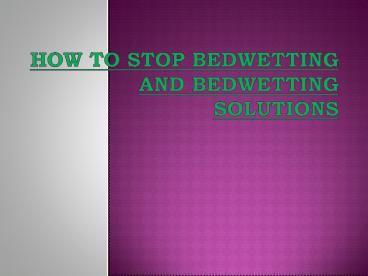How To Stop Bedwetting And Bedwetting Solutions - PowerPoint PPT Presentation
Title:
How To Stop Bedwetting And Bedwetting Solutions
Description:
Bedwetting is an unintentionally passage of urine during the sleep, this is the most embarrassing issue among kids; bedwetting is sometimes called nocturnal enuresis. – PowerPoint PPT presentation
Number of Views:24
Title: How To Stop Bedwetting And Bedwetting Solutions
1
HOW TO STOP BEDWETTING AND BEDWETTING SOLUTIONS
2
- Bedwetting is an unintentionally passage of urine
during the sleep, this is the most embarrassing
issue among kids bedwetting is sometimes called
nocturnal enuresis. - Children in general stop day time wetting by the
time they are 3 years and stop wetting at night
when they reach 5 years of age, but in some cases
even a well grown child wet the bed. Children who
wet the bed have no control and they dont wake
up when their bladder is full. There can be
medical causes, so it's a good idea to have a
check by your doctor.
3
- Enuresis is the medical term for uncontrolled
bedwetting. It is the unintentional sleep wetting
by a healthy child above 5 years of age. For
bedwetting advice, the first stop should be to
your pediatrician or qualified medical
practitioner.
4
- Kegel exercises can help to strengthen weak
muscles around the bladder. The exercise involves
contracting and relaxing the pelvic muscles. A
specialist may use biofeedback to tell them if
the patient is doing the exercises properly. The
procedure is noninvasive. Two sticky patches are
placed on the child's bottom and connected to the
biofeedback machine. A child usually goes for
therapy every two to four weeks over the course
of three to six months. To be effective, the
child must practice at home, three times a day.
5
- When behavioral therapy is recommended, the
DryBuddy child-friendly moisture alarm alerts the
parent AND child. The parent can then follow the
proper hygiene and other recommended procedures.
This process reduces the incidence of primary
nocturnal enuresis (PNE). A parent or caregiver
often has to supervise the child when an incident
occurs.
6
- Various studies suggest that enuresis or
bedwetting alarms are the preferred method for
treatment. Commitment on the part of the patient
and the caregiver is essential to improving the
success rate of alarm therapy. The success of
alarms requires a motivated child and family plus
a significant time and effort commitment of 3 to
6 months. - For more informations log onto
http//www.drybuddyflex.com/































